- Data Calling
- Posts
- The Causes of Political Violence
The Causes of Political Violence
Are we reliving the 60's or is this different?

In the past decade, the United States has seen a sharp rise in politically motivated violence. The 2017 congressional baseball practice shooting that left Representative Steve Scalise critically injured, the January 6th attack on the U.S. Capitol, the 2022 assault on Paul Pelosi, the attempted assassination of President Trump during a 2024 campaign rally, the killing of Minnesota Speaker Melissa Hortman and her husband in June, and most recently, the murder of conservative activist Charlie Kirk last month all show how real the threat has become.
Political violence is not an ordinary crime and is defined as the use of force, intimidation, or threats to achieve political ends. For years, Kirk had been a lightning rod in American political life, sparking both fervent support and intense criticism for his words and approach. His death is not just a tragedy (whether you were among his supporters or opponents), but in the ongoing debate about the rising issue of political violence in the United States, is likely a ‘turnpoint’. What is unknown is if this is the start of a new direction, or just a continuation in the escalation of political violence in this country.
Just the Beginning or a Turning Point?
Our recent national survey of 1,000 adults asked Americans whether they saw Charlie Kirk’s death as the beginning of something worse or as a moment when people might tone down their rhetoric. The view points reveal both agreement and divisions. Among all Americans, 47% feel it marks the beginning of something worse, while only 23% believe it will lead people to tone down their rhetoric. A large share of respondents, over 30%, are unsure, reflecting widespread uncertainty and anxiety about the nation’s political direction.
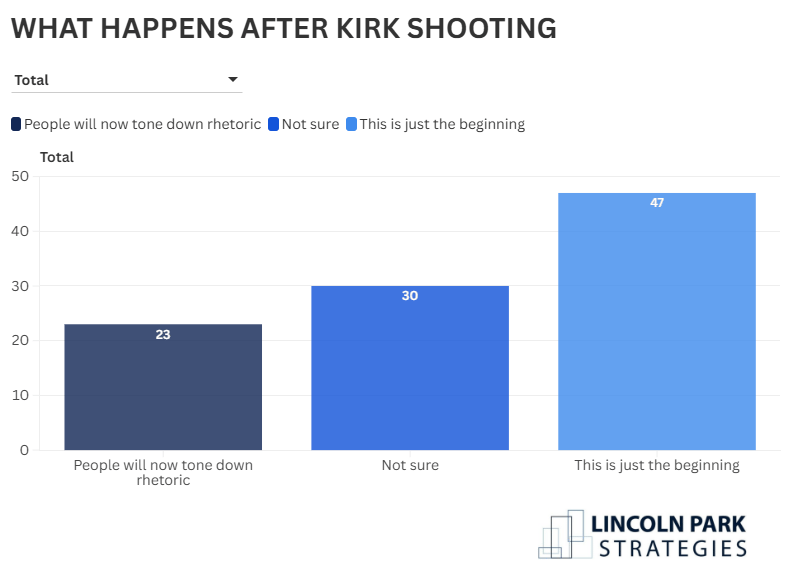
Blue States, Swing States, and Red States alike lean toward the view that this is the beginning of something worse, with very little difference between the three groups. Similarly, there is little to no difference when it comes to race. The differences start to show when we look at age and partisanship. Millennials and Gen Z Americans are nearly evenly divided, though slightly leaning toward the belief that this event is just the beginning of more to come. Meanwhile, 58% of Boomers and 47% of Gen X share the concern that this is just the beginning. The viewpoint of Boomers is especially concerning given the fact that they are the only generation (that still has a sizable number of living members) who experienced the political violence of the 1960s.
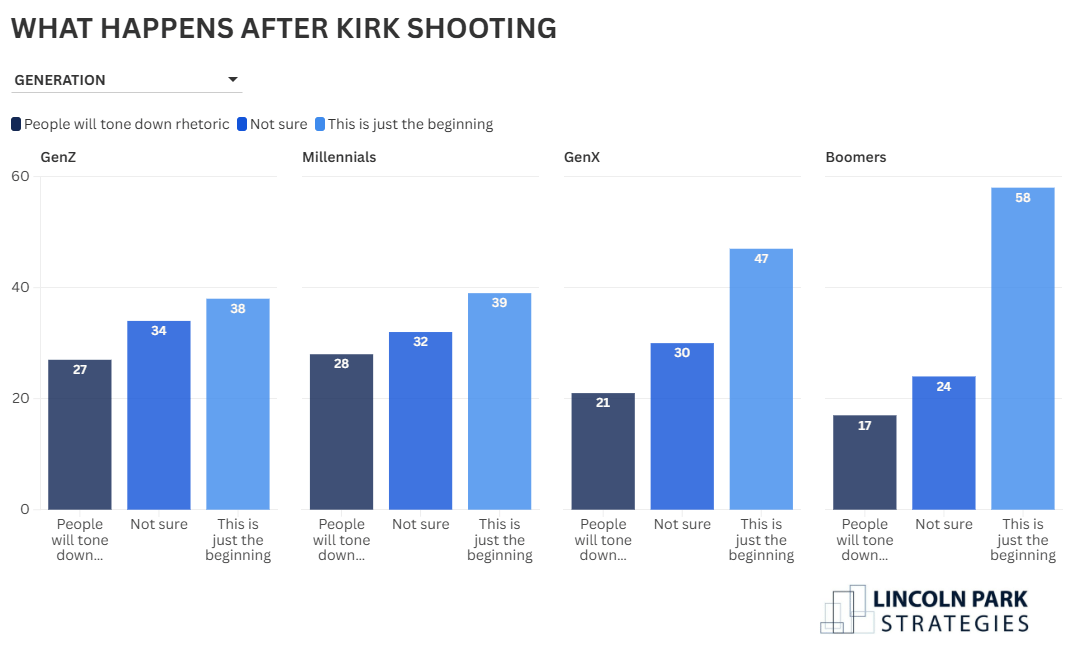
Interestingly, about 40% of Republicans view the tragedy as a potential moment for national reflection, a chance to pause and tone down the rhetoric that has built up over time. In contrast, 57% of Democrats and 52% of Independents believe that Kirk’s shooting signals the beginning of something worse.

These partisan divides closely mirror 2024 presidential vote preferences: Trump voters are almost evenly split on what this event is likely to mean, while 60% of Harris voters feel that this tragedy marks the start of a darker turn.
What Americans Think Causes Political Violence
Regardless of what Americans feel is likely to happen in the near future, we wanted to understand what they view as the cause of this increase in political violence. To understand public attitudes we asked Americans to rate a list of possible causes, including rhetoric from the left, rhetoric from the right, social media, and easy access to guns on a 0 to 100 scale, where 100 means it is one of the biggest contributors to the political violence, and a 0 means it has nothing to do with it. With this approach we are allowing respondents to give a little more nuance to their answer and not force them to pick just one reason.
Overall, social media receives the highest average score (66.88) while easy access to guns is not far behind at 65.18. Political rhetoric from the Right (58.17) was slightly higher than rhetoric from the Left (57.99) but both are a clear step below the other options presented.

When looking at the demographic data, clear divisions emerge in how different groups perceive the causes of issues like social media and easy access to guns, as well as rhetoric from the left and right. These differences highlight how age, race, political affiliation, and geography shape public opinion.
If we pair these causes into two groups, we can see that there is an overall divide when it comes to social media versus easy access to guns. Looking at how these numbers breakdown (versus the average), we find that there is a large spread of opinions at the middle to higher end of the scale. Nearly 2/3rds of all Americans rank social media’s share of the blame at a 60 or higher on the 0 to 100 scale (including a quarter who rank it at 90 to 100.
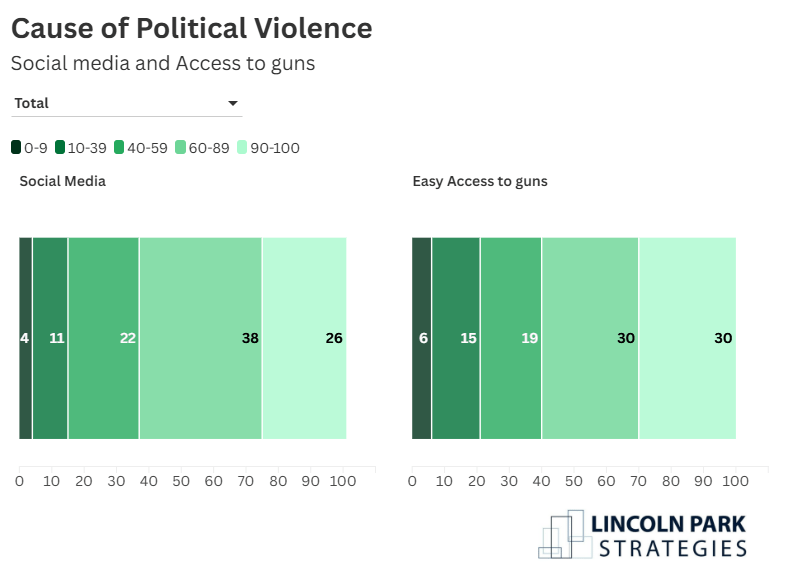
The response for easy access to guns is similar with 60% ranking this factor at a 60 or higher. Very few Americans feel that either of these share little to no blame, with 4% ranking social media at a less than a 10 and 6% using the same ranking for the access to guns.
Looking at the numbers as just a straight-up which was ranked higher, the divide on these opinion is quite clear.
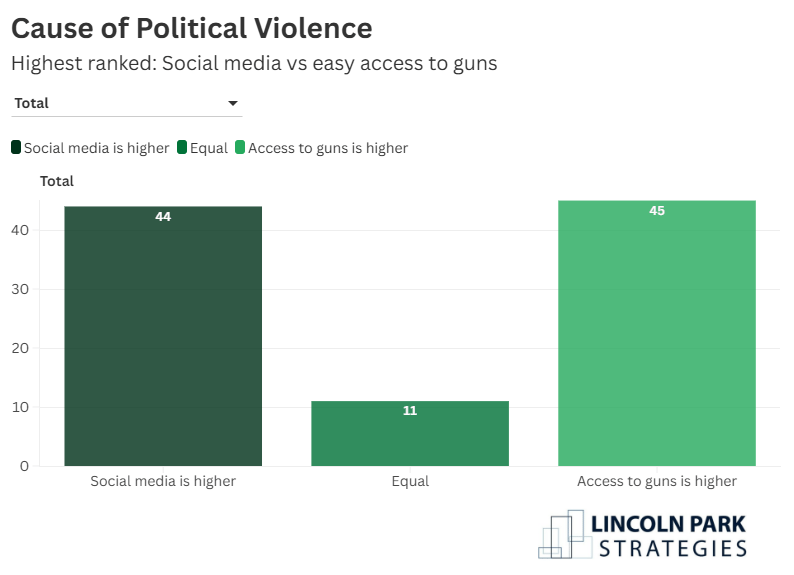
When it comes to age, Gen Z Americans view social media having the bigger effect, while Millennials and Boomers view access to guns as the bigger factor. GenX is more divided in their views.
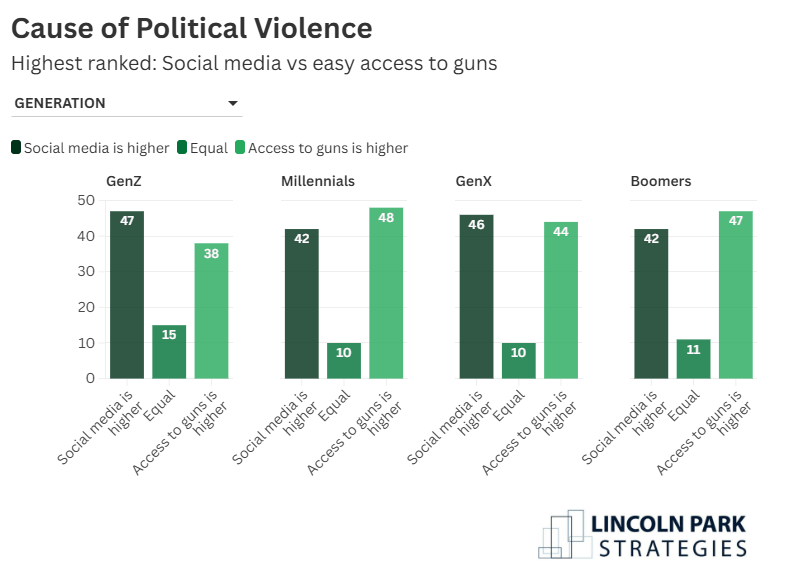
The middle generations (Gen X) show moderate views on both, highlighting their position as a transitional group between tech-native youth and more traditional Boomers.
Not surprisingly, there are differences when we look at political views. Six in 10 (60%) of Republicans feel that social media is the bigger factor, while 31% place more blame on social media. Democrats are the near opposite with 60% saying that access to guns is more to blame, and 28% pointing to social media. Independents are on brand and land in the middle, nearly evenly divided.
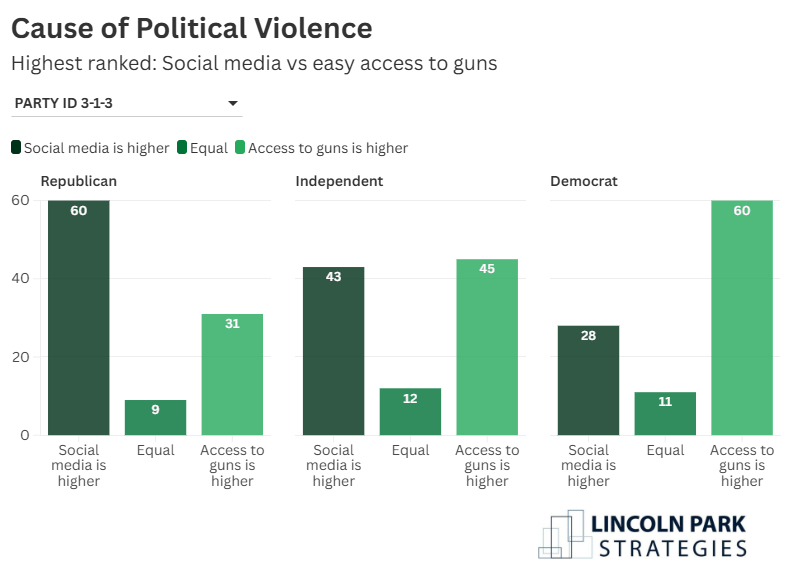
When it comes to political rhetoric, the overall averages are evenly divided as are the breakdown of the responses. Forty-eight (48%) of Americans rank both side’s rhetoric at a 60 or higher on the 0-100 scale.
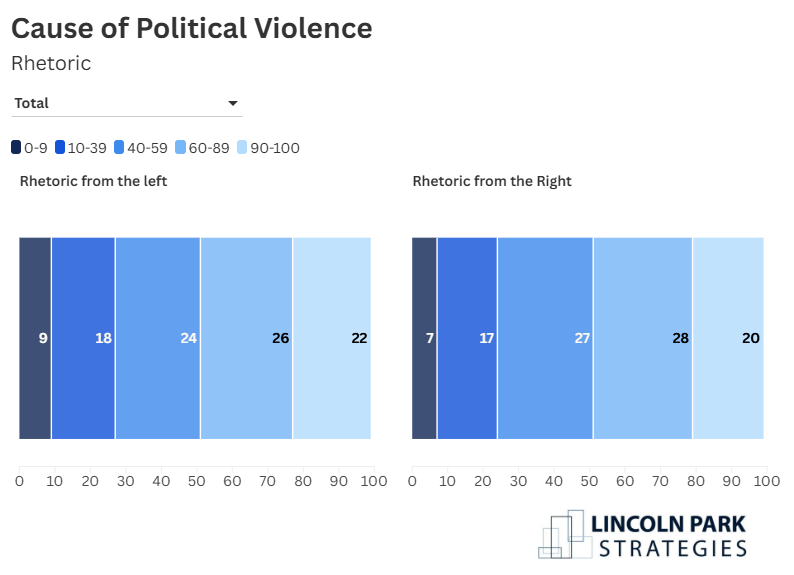
The numbers are also similar when looking at which side gets the most blame. Rhetoric from the right has a slightly higher concentration of blame albeit by only two-points.
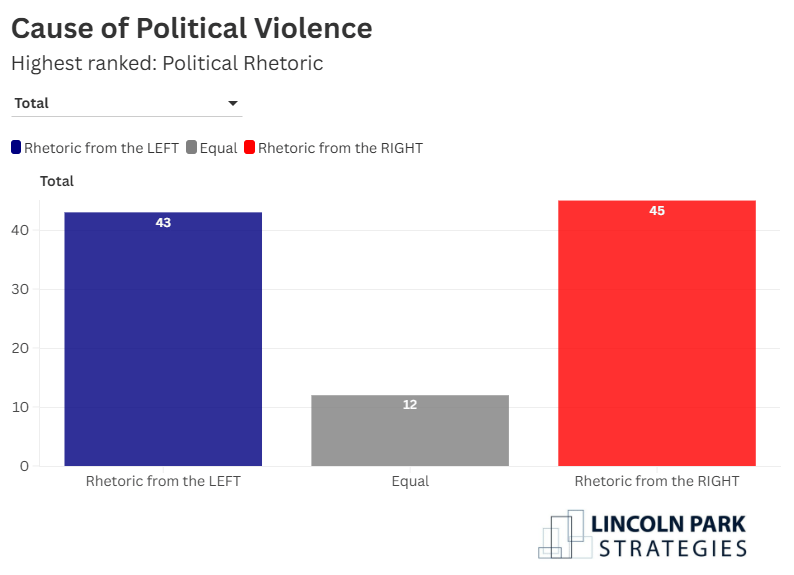
While supporters of Trump and Harris having different opinions on the question is not exactly news or shocking, what is arguably interesting is the fact that a third of the President’s 2024 supporters place more blame on rhetoric from the right. At the same time, 25% of Harris voters place more blame on rhetoric from the left.
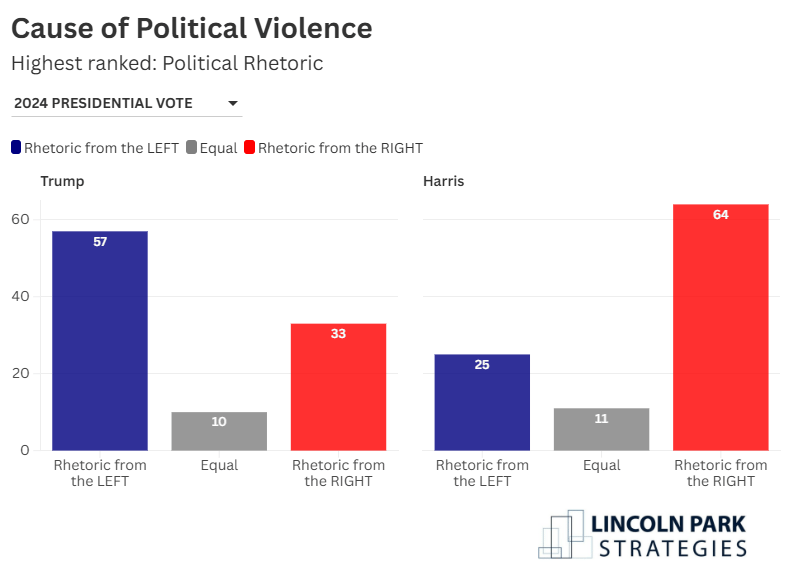
Why Political Violence Is Rising
Gen Z, as the generation most active on social media, is likely to see online platforms as the main cause of violence; Boomers will want to blame social media for everything; Black communities, who suffer disproportionately from gun violence, often point to firearms as the root cause; meanwhile, those on the political left blame the right, and those on the right blame the left. While data reveals certain patterns backing up these generalities, it is difficult to separate these perspectives from bias, making it nearly impossible to identify a single, definitive cause.
The data/evidence suggests that political violence cannot be pinned on a single factor. Rather, it emerges from the interaction of multiple risk forces, rhetoric, media, weapons, and social division, each feeding into the other. Social media platforms, driven by engagement algorithms, elevate outrage and misinformation, amplifying ideological extremes. Rhetoric, in turn, validates these digital emotions, giving them political legitimacy or vice-versa. When combined with easy access to firearms, this ecosystem creates a volatile environment where online hostility can turn deadly in seconds.
Kirk’s murder was not an isolated event. It reflected a collision between symbolic politics, media culture, and public anger. Easy access to guns is the highest ranked issue in most communities and overall because it’s usually seen as the most direct and preventable cause of violence. If there were no guns, there’s no means to kill. But our polling shows that even though in some communities where there are strong anti-gun preferences, causes of violence cannot be narrowed down to just one item. Rhetoric from left (17%), rhetoric from right (14%), social media (21%), easy access to guns (27%), others (21%) all receive an almost even level of distribution.
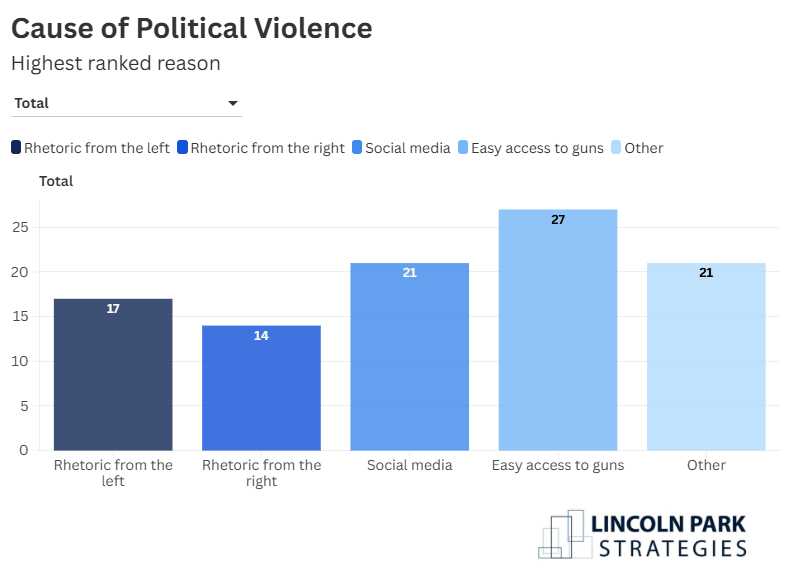
Between rhetoric left (43%) and rhetoric right (45%), it is more or less balanced, similar to social media and guns, which solidifies the statement that everything is independent of each other or is biased. As polarization deepens, more Americans are coming to view opponents as existential threats rather than fellow citizens, an emotional state that makes violence appear, to some, tragically justified.
Conclusion
“An eye for an eye can make the whole world blind.”
If the current trajectory continues, political violence risks becoming normalized, a grim “new normal” of democratic life and advocacy. The data shows Americans recognize these dangers. Unless the country can find ways to lower the temperature, Kirk’s death may be remembered not as a turning point but as another milestone on the road to deeper instability. The choice now is whether to treat this tragedy as a warning, or as another weapon in an already overheated political war. Right now, Americans are unclear on which this is.
The Lincoln Park Strategies Team
